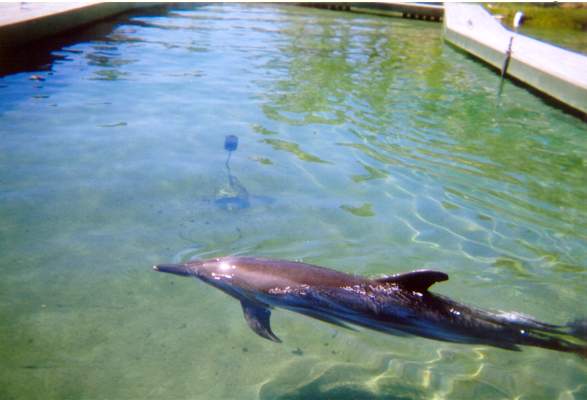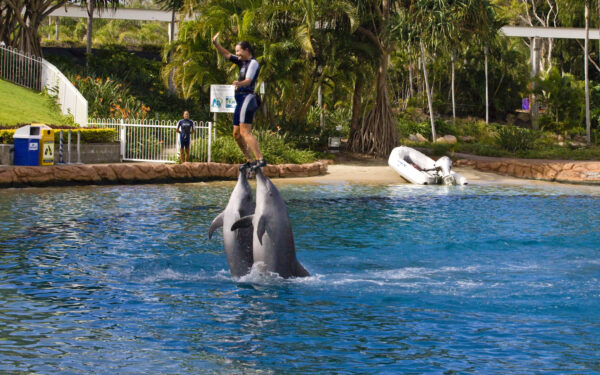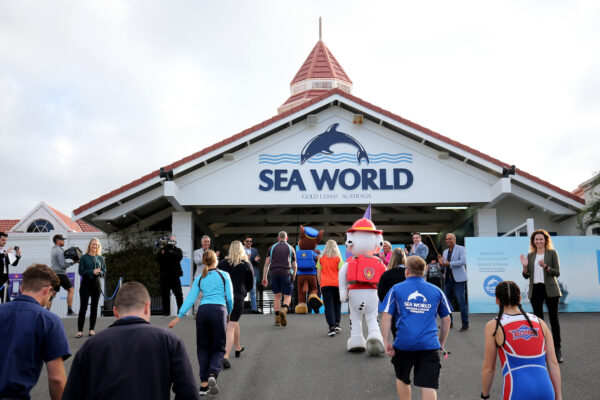Sea World is now the only place in Australia breeding dolphins in captivity. The RSPCA says it must stop but the park says parenthood is good for its dolphins.
When a small NSW tourist park volunteered last year to stop breeding dolphins, Sea World suddenly found itself alone.
The Queensland attraction is now the only one in Australia breeding dolphins in captivity, something the RSPCA says cannot be justified and should be outlawed.
But Sea World has no plans to halt its managed breeding program, saying it makes an enormous contribution to the welfare of the dolphins it keeps.
And the Queensland government says it won’t be following NSW, which last year banned captive dolphin breeding.
It was imposed after NSW’s sole remaining operator—the Dolphin Marine Conservation Park at Coffs Harbour—said it would no longer engage in the practice.
Further breeding was never really on the cards because the park’s three remaining dolphins—all born at the park—are related. But what the ban has done is effectively end the use of dolphins for entertainment in NSW.

It has long been illegal in Australia to capture wild dolphins for commercial purposes and without permission to breed, any new operator in NSW would be unable to maintain a captive population.
Sea World, on Queensland’s Gold Coast, is now entirely alone in terms of Australian captive dolphin breeding programs linked to commercial enterprise.
Every year, millions of tourists pay to visit the park which offers adrenaline-pumping rides alongside opportunities to learn about and interact with a range of animals, including its 27 dolphins.
Visitors can also watch dolphins perform in shows and pay extra to swim with them.
Without doubt, some of the dolphins now on show would not be alive had Sea World not rescued and nursed them back to health and given them a home.
Take RAAF, for example. He was found as a young calf, badly sunburnt and stranded on the high tide mark at Evans Head in NSW.
After weeks of care he recovered but could not be released because he never learned how to survive in the wild.
But Sea World also breeds the two species it keeps—the offshore bottlenose dolphin and inshore bottlenose dolphin neither of which is endangered or threatened.

The RSPCA says given the health of wild bottlenose dolphin populations there are no grounds to continue captive breeding.
“Young dolphins should not be born and raised in an artificial environment, and be destined to live for several decades in pools and tanks where space is limited and the opportunity to express many natural behaviours is denied,” it wrote last year in a submission to a NSW parliamentary inquiry into the exhibition of cetaceans.
Wayne Phillips has been Sea World’s head of marine sciences for the past two years and says “conservation education” and animal welfare are the main reasons the park breeds dolphins.
“These animals are ambassadors for their species. We see a strong role for zoological facilities in educating the public and maintaining that connection to nature,” he told AAP.
He says Sea World’s dolphins also have richer lives thanks to breeding.
“Just like grandkids, they bring a whole zest and life to any household. We’re not going to remove something that’s positive for the animals.”
The last birth was about two years ago and reproduction is carefully managed to ensure the three-dolphin lagoon systems aren’t over populated. Generally that means keeping males and females apart, and occasionally the use of contraception.
If a pregnancy is desired, only non-related animals are paired.
Phillips also points to welfare initiatives including regular independent evaluations and continuously gathered data on key indicators such as appetite and willingness to participate in activities.
But critics say as long as Sea World has permission to breed, it has a guaranteed supply chain. Of its 27 dolphins, 19 were bred there.

Animal Justice Party MP Emma Hurst was deputy chair of the NSW cetaceans inquiry and is among those demanding a Queensland ban on breeding.
She says the state government is in denial about the inevitable death of dolphin parks and fading public appetite for seeing intelligent, social animals confined in artificial environments.
“Bans on the use of cetaceans in entertainment are occurring globally, with France and Canada recently introducing bans. Queensland’s lack of action is becoming a global embarrassment,” she says.
“A dolphin born into captivity could live for up to 50 years. What will happen to a dolphin born into captivity today —in 30 or 40 years’ time—if they are no longer profitable?”
Isabella Clegg is an independent animal welfare expert Sea World pays to assess its efforts.
“From the data I’ve collected at Sea World for the past two years, I believe most of their cetaceans are in good welfare, most of the time,” she says.
Evidence suggests being able to reproduce is good for captive dolphins, she adds.
“The presence of young dolphins in the group … increases positive social behaviour in adults, gives the opportunity for females to experience very close social bonds and reduces male coercive behaviour to female.”
Clegg says the question of whether dolphins should be allowed to reproduce in captivity is an ethical one that feeds into the broader issue of whether there is public support for the continuation of dolphin facilities.
“I don’t believe that public opinion is clear (on that),” she says.
“Ultimately, the continuation of aquaria and marine parks should be debated in the same light as all zoos.
“I believe the Queensland government and others need to look at whether and how having wild animals on public display supports or does not support education and conservation of nature.”
In Queensland, Sea World’s dolphins are covered by the Exhibited Animals Act, which falls into the portfolio of Agriculture and Fisheries Minister Mark Furner.
He told AAP a ban on breeding wasn’t under consideration and the act ensures risks to animal welfare are “mitigated or minimised.”
By Tracey Ferrier
 RSS Feed
RSS Feed















 May 15th, 2021
May 15th, 2021  Awake Goy
Awake Goy  Posted in
Posted in  Tags:
Tags: 













